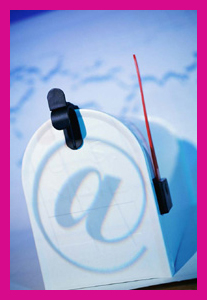Six Email Tips to Save Time
 Like most of you, I receive an overwhelming volume of e-mail each day. I get e-mails from clients, my volunteer work, list-serves, family, etc. It’s simply exhausting. In order to preserve my sanity, it was critical for me to develop effective, time saving e-mail management techniques. Here are a few of my secrets:
Like most of you, I receive an overwhelming volume of e-mail each day. I get e-mails from clients, my volunteer work, list-serves, family, etc. It’s simply exhausting. In order to preserve my sanity, it was critical for me to develop effective, time saving e-mail management techniques. Here are a few of my secrets:
Self-Management
Filters can help you save time by having your e-mail program manage itself. E-mail programs such as Outlook, Gmail, and Entourage can be configured to filter emails directly into folders. This includes sending spam directly to the trash. By filtering your e-mail, you’ll be able to selectively read mail in each folder as time allows.
Not on Demand
Conditioned like Pavlov’s dog, many of us are trained to respond to e-mail as soon as we hear “you’ve got mail.” If your e-mail program announces when mail arrives, turn off this feature or simply turn down the volume. You will be able to better focus on the project at hand.
Set a Time
Your work flow is disrupted if you stop to answer e-mails as they arrive. Your productivity will increase if you set aside a specific time each day to review and respond to e-mail. You may need only one block of time or your inbox may require more frequent reviews. If you set aside dedicated times to responding to mail, you’ll boost your efficiency.
Avoid Peak Hours
Most e-mail responses don’t require great thought, creativity, or analytical concentration. Therefore, avoid answering e-mails during your most productive time of the day. I am most creative and productive in the morning. Sometimes answering e-mails first thing in the morning can drain me of that positive energy. Put that power time to full use and save your e-mail replies for a time when you’re not at your peak performance.
Discover Technology
Using a smart phone with wireless technology (iPhone, Treo, Blackberry) allows me to use my unexpected downtime for practical purposes. If I arrive at a meeting early, find myself stuck in an airport, or simply don’t want to be tied to my computer on a beautiful day, I can use my phone from almost anywhere to quickly respond to e-mails. When I return to my office, I breathe a sigh of relief when I open my e-mail inbox and realize I’ve already responded to most of the messages.
Read, Respond, File. Repeat.
Use e-mail folders just like a paper file system. If you save e-mails, create folders and sub-folders for your inbox. This will make finding older mail simple and keep your inbox empty. For example, all e-mails from my family go into one specific folder. All e-mails related to my business go into a different folder. I use the “read, respond, and file” method as a great way to manage my inbox.

